One of the most thrilling niche sports, powerboat racing brings the high-octane excitement of auto racing to an aquatic arena. If you’re a bit of a daredevil who enjoys spending time out on the open water, powerboat racing may be alluring to you. However, this is a sport you cannot simply jump into.
You will need to take some time to understand the intricacies of powerboat racing and how to stay safe before you start practicing and enter your first race. Even if you’d rather remain a spectator, you will still need to learn the details of the sport, as it is more complex than you may think.
Whether you’re an aspiring powerboat racer or a new fan, this guide aims to provide you with the knowledge you’ll need to get started.
History of Powerboat Racing
Powerboat racing is becoming more popular, but it is far from a newcomer to the motorsport industry. The first autoboat races were organized in 1903 by the Automobile Club of Great Britain and Ireland and its offshoot, the Marine Motor Association. The next year, offshore powerboat racing became an official sport following a race from England’s southeastern coast to Calais, France.
The sport would soon cross the Atlantic and gain a foothold in the United States, with the first record race taking place in California in 1911. Powerboat racing has gone through various transformations through the years. The comparatively humble early power boats have evolved into modern super boats, and contemporary races are shorter and held on track-style circuits. There were only four classes of power boats from the 1960s through the 80s, but today, there are almost 100 different classes and 13 categories of powerboat races.
Powerboat racing has also become more spectator-friendly over the years. Larger events usually offer bleacher seating, but these tickets can be difficult to get your hands on. Most events allow you to bring your own chairs and set up along the coast, which is often the best vantage point.
Staying Safe
A powerboat race is an exhilarating experience with an adrenaline rush that’s hard to match. However, the sport can be dangerous if you don’t follow the recommended safety standards. Those who are looking to get into powerboat racing will need to spend many hours going through safety training and studying the official rule of powerboat racing organizations.
Additionally, you will need to invest in safety equipment, such as:
- Helmet – To enter official races, your helmet must meet the safety standards of either the American National Standards Institute or Snell, or you can wear military-specification helmets. The top half of the helmet must be a high-visibility color, such as yellow or orange.
- Life jacket – The American Power Boat Association (APBA) requires all racers to wear a life jacket in compliance with the APBA Lifejacket Manufacturing Specifications, with the upper 70 percent of the jacket either orange or yellow.
- Driving suit – The APBA requires all racers to wear protective clothing underneath their life jackets. Inboard racers are required to wear fire-resistant suits, while outboard racers must wear cut-resistant sleeves and pants primarily made of Kevlar.
- Racing shoes – The APBA allows drivers to wear any type of closed-toe shoe, but it is worth investing in a pair of specialized racing shoes if you are looking to compete.
- Gloves – Drivers are not required to wear gloves, but they can make it easier to maintain your grip on the wheel.
- Neck restraint – There is no APBA requirement for neck restraints, but racers often use them to protect their necks and backs from the physical toll of frequent racing.
The Costs of Powerboat Racing
Taking up powerboat racing is expensive, and your expenses will go well beyond what you pay for the boat itself. Owning any type of boat will be expensive, primarily due to the costs of maintenance, repairs, and replacement parts. Power boats are no different, and they may be more expensive to maintain if used frequently.
The main expenses of owning a power boat include:
- Fuel
- Spare parts
- Engines
- Trailers
- Tow rigs
- Maintenance crews
- Insurance
- Race entry fees
- Travel expenses
Powerboat racing doesn’t just cost money. Participating in this sport is also a major time commitment. More casual racers may be able to find the time to race with friends or acquaintances, but those looking to race in major events will need to dedicate significant time to the pursuit. Racers will usually be gone for about four days each race, and many racers also have obligations to participate in sponsor events.
If you have a family or major professional commitments, it might be best to make powerboat racing a more casual hobby or simply become a passionate fan of the sport. However, those with the finances and spare time to dedicate to learning the sport will be rewarded, whether they go pro or simply become dedicated hobbyists.

